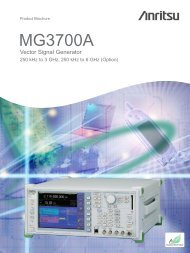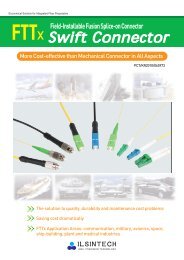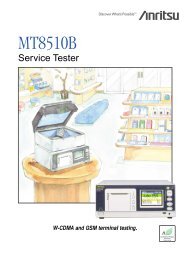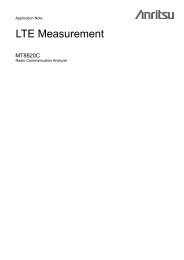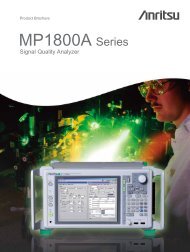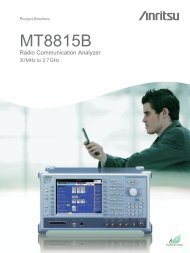Tower Mounted Amplifiers, Diagnostics and Isolation ... - Opticus
Tower Mounted Amplifiers, Diagnostics and Isolation ... - Opticus
Tower Mounted Amplifiers, Diagnostics and Isolation ... - Opticus
Create successful ePaper yourself
Turn your PDF publications into a flip-book with our unique Google optimized e-Paper software.
SiteMasterApplication NoteTest ProcedureDTF-Return Loss ModeStep 1. Press the MODE key.Step 2. Select DTF-RETURN LOSS using the Up/Down arrow key <strong>and</strong> press ENTER.Step 3. Set the start <strong>and</strong> stop frequencies, F1 <strong>and</strong> F2, F1 = 1850 <strong>and</strong> F2 = 1990.Step 4. Connect the Test Port Extension cable to the RF Out port <strong>and</strong> press START CAL to calibrate theSite Master.Step 5. Follow the Site Master instructions on the screen <strong>and</strong> press SAVE SETUP to save the calibration.Step 6. Connect the jumper to the Site Master phase stable Test Port Extension cable <strong>and</strong> connect load tothe antenna jumper.Step 7. Press the FREQ/DIST key.Step 8. Set the D1 = 0 <strong>and</strong> D2 = 110 ft values. The Site Master default for D1 is zero.Step 9. Press the DTF AID soft key <strong>and</strong> select the appropriate CABLE TYPE to set the correct propagationvelocity <strong>and</strong> attenuation factor.NOTE: Selecting the right propagation velocity, attenuation factor <strong>and</strong> distance is very important for accurate measurements,otherwise the faults cannot be identified accurately <strong>and</strong> insertion loss will be incorrect.Step 10. Press SAVE DISPLAY, name the trace, <strong>and</strong> press ENTER.Step 11. Record the connector transitions.Analysis of DTF-Load SweepCarrier specifications for DTF-Return Lossplots are typically –30 dB for connectors<strong>and</strong> –45 dB for the cable/transmissionline. In figure 10, all markers (M1-M4)are below the –30 dB level indicating thatthe connectors <strong>and</strong> the transmission linemeet specification. Markers M3 <strong>and</strong> M4,the TMA jumper does not indicate a problembecause the readings are below –30 dB.Therefore, the problems must be with thetower-mounted amplifier.dB-20-25-30-35-40-45-501stJumperDistance To Fault0.0 - 110.0 Feet (cal on, 6.0 dBm, Rectangular Windowing)M1: -33.979 dB @ 10.233 Feet M2: -41.938 dB @ 81.006 FeetM3: -41.132 dB @ 86.124 Feet M4: -50.458 dB @ 97.209 FeetM1 M2 M3 M4MainFeederTMAJumperAntennaJumper0 10 20 30 40 50 60 70 80 90 100 110Distance (0.0 - 110.0 Feet)10Figure 10. DTF-Return Loss Load SweepAntenna-to-Antenna <strong>Isolation</strong> with the Site Master S251CMeasuring Antenna-to-Antenna <strong>Isolation</strong> between adjacent systems is very important when deploying multiplesystems on the same tower. It helps to determine the potential threat of interfering signals <strong>and</strong> maximizescapacity of the Base Station. Site Master S251C simplifies this by indicating the isolation between systems withoutthe need of calculating coaxial losses <strong>and</strong> antenna gains.An example of adjacent PCS systems is shown in Figure 11. System 1 transmits signal in a specific direction, butsome of the signal is received by antenna 2. Any excessive signal level from transmitter 1 will cause poor performance,loss of communication, <strong>and</strong> system degradation in the adjacent system. Antenna-to-Antenna isolation(more commonly known as the system isolation) is the difference between the output level transmitted by system1 <strong>and</strong> the signal level received by system 2. The system isolation is equivalent to the reduction of signallevel (attenuation) of Transmitter 1. Typical levels for isolation between systems can vary from 50 dB to 100 dB.



